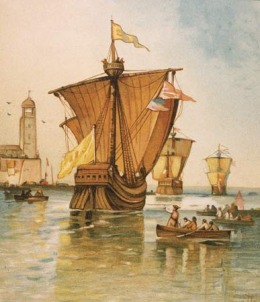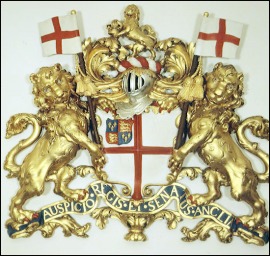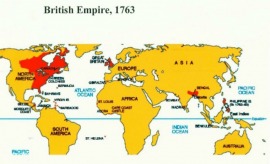BRITISH OVERSEA EMPIRES
NORTH AMERICAN COLONIES

The English Empire had many colonies during the period of 1500-1700. Some colonies that the English Empire colonized in North America were Newfoundland, The Thirteen Colonies, and a huge land surrounding Hudson Bay. Belize, Hispaniola, Jamaica, Curacao, and Barbados were colonies the English (AKA BRITISH) Empire colonized in Central America. In Africa, the British colonized Taso and Gambia. In Asia, Bombay, Madras, and Ft.William (Calcutta) was colonized. These places that the English Empire colonized were all near water lands.
During the 1500's, most industries depended on other land the British colonized to support them with the raw materials they used. For example, shoes, wool-which is used for clothes, grapes - which is used for wine, and hops. The British also used these colonized countries as banks to keep up their wealth, to increase trade around the world, and most of all, their ultimate goal to achieve was to be the best in Europe. One of the first overseas colony to be colonized was Newfoundland. The British decided to claim the first colony because they were envious of the wealth Spain and Portugal have gained from colonizing land. In 1497, John Cabot claimed Newfoundland for the British. During the time British owned Newfoundland, Sir Humphrey Gilbert in 1583 visited St. Johns. Queen Elizabeth the first sailed along with Sir Humphrey Gilbert. During Sir Gilbert's visit to St. Johns, he called a meeting with the masters and chief officers of all the ships in the nation. He then formally took over many lands under the name of Queen Elizabeth the first. Until the 1713 Treaty of Utrecht, the title which Sir Gilbert had taken for the British was argued and debated occasionally.
Another part of the North American Colonies that the British colonized was the Thirteen Colonies. The time period where the Thirteen Colonies became colonized was between 1607 - 1732. The British had many settlements, trades, and work begin in the 13 colonies. These areas were chosen because of the easy transport from sea to Britain and because of all the supplies these 13 colonies can supply Britain, the British encouraged many people settle in the new land because the British wanted to have more men help out with the trade, more men to help out with the overall settlement and material gathering. During those 125 years, Britain had taxed the 13 colonies repetitively. Many of the settlers in the 13 colonies were unhappy because the British taxed the settlers like they had useless gold to throw away. As more and more colonies were being colonized, the British would tax the colony settlers. As more and more taxes were given and demanded, there was more rebellion in the colony land.
One of the largest lands Britain colonized was the land surrounding Hudson Bay. This land that surrounded Hudson Bay was also known as Rupert's Land because Rupert was the first governor of the company which held this land. This land was held by the Hudson's Bay Company at the start of 1670. Pierre Radisson and Medart de Groseilliers found this land which we call Hudson Bay. This land was created because the French refused to listen to these couriers’ word about the riches they found in this land. When the French declined the couriers’ ideas, these two Coureurs, Radisson and Groseilliers, went to the English and told them about the riches in this land they found during one of their explorations. The English agreed to look at this land because they thought they had the right to take over any land that would provide wealth to their own country. The HBC had trading posts where they wanted the Natives, who lived in Rupert's land, to come and trade with them. When this plan was put into action, many natives were eager to trade with the English. The Natives had to trade one set of fur for a couple of Made beaver Tokens so they could purchase many objects or belongings from the English.
CENTRAL AMERICA COLONIES

In Central America, the colonies that were colonized by the British were Belize, Hispaniola, Barbados, and Jamaica. Belize had settlers coming from British around 1638. The settlers were British Pirates which were called Baymen worked in Belize as a logging industry. As more people saw the Baymen settle in the colony, many other European settlers brought along their African slaves to settle in this place. The British picked this place to start a colony because there were logs that the European used for dyeing clothing. There were a lot of those types of logs in Belize. Hispaniola was first found in 1492 by Christopher Columbus. Christopher Columbus was on his exploration for a new land when he first stumbled against this land. This land was filled with famines, forced labors, and some smallpox.
Under the command of Captain John Powell in 1625, the first English ship arrived in Barbados. Two years later (1627), was the first settlement the British had. This land was claimed for King James I in 1663. Around 1630, sugar canes were introduced to the Barbados. A few years before Sugar canes were introduced, many people were trying to figure out ways to make tobacco and cotton plantations. Jamaica was invaded and taken from the Spanish by the British in 1657. In 1661, the British gained more colonization. The year of 1670, the English gained more possession and power from the Treaty of Madrid. Around those years, the English burned down the Spanish capital, Villa de la Vega and renamed it Spanish Town, keeping it as the island's capital like before. The British at this time wanted as much land as possible so, the British thought Jamaica was an important piece of land. As soon as the British had the land, they kept a lot of African slaves there to do work commoners and others would not do.
AFRICAN AND INDIAN COLONIES

The opposite side of the world also contained colonies the British colonized. Some of these colonies include Taso and Gambia from Africa and Bombay, Madras, and Fort William (Calcutta) from India. In 1587, Charles II used the colonized land, Gambia to buy slaves for plantations in America and West India. During the same period of time, other trades were in process. There were people from the English who started exploring the Gambia River in 1618. In 1661, the land which was called St. Andrew's Island was captured and renames James Island because those explores found land after exploring the river for so many years. During 1765 on James Island was the first English settlement on the West African Coast.
In India, the British firstly colonized was Madras in 1639. The British East India Company started a settlement in the fishing area. Later on, this settlement which was known as Fort St. George became a trading post. Madras was the first outpost of the British East India Company. In Madras, the British East India Company built a fort which was finished on St. George Day of 1640. The next colony to be colonized was Bombay. Bombay was given to King Charles II with his marriage with a Portuguese Princess in 1662. In 1668, the English East India Company took over Bombay because annually, the people in Bombay find approximately 10 pounds of gold. However, the British cared very little of this land. There was not a lot of trade between Bombay and the British. The last Colony to be colonized in India was Ft. William (Calcutta). This land was found by a British trader called Job Charnock. The East India Company moved their trading station to Calcutta because of 1690’s war with Mughals. During 1696 to 1702, there was a fort built in Calcutta. Near 1699, the East India Company was developing Calcutta as a Presidency city.
During the 1500-1700's the English Empire colonized a lot of land all over the world from the largest colonies to the smallest. Some colonies caused a lot of rebellion while some were treated harshly. Over these two hundred years, the English has had there ups and downs. With so many colonies colonized, some rulers use a lot of effort to rule over all the land that the country they are in control of.
COLONIES OVER THE WORLD

THE RED PARTS THAT ARE IN THE MAP ARE THE COLONIES COLONIZED BY THE BRITISH IN 1763.

